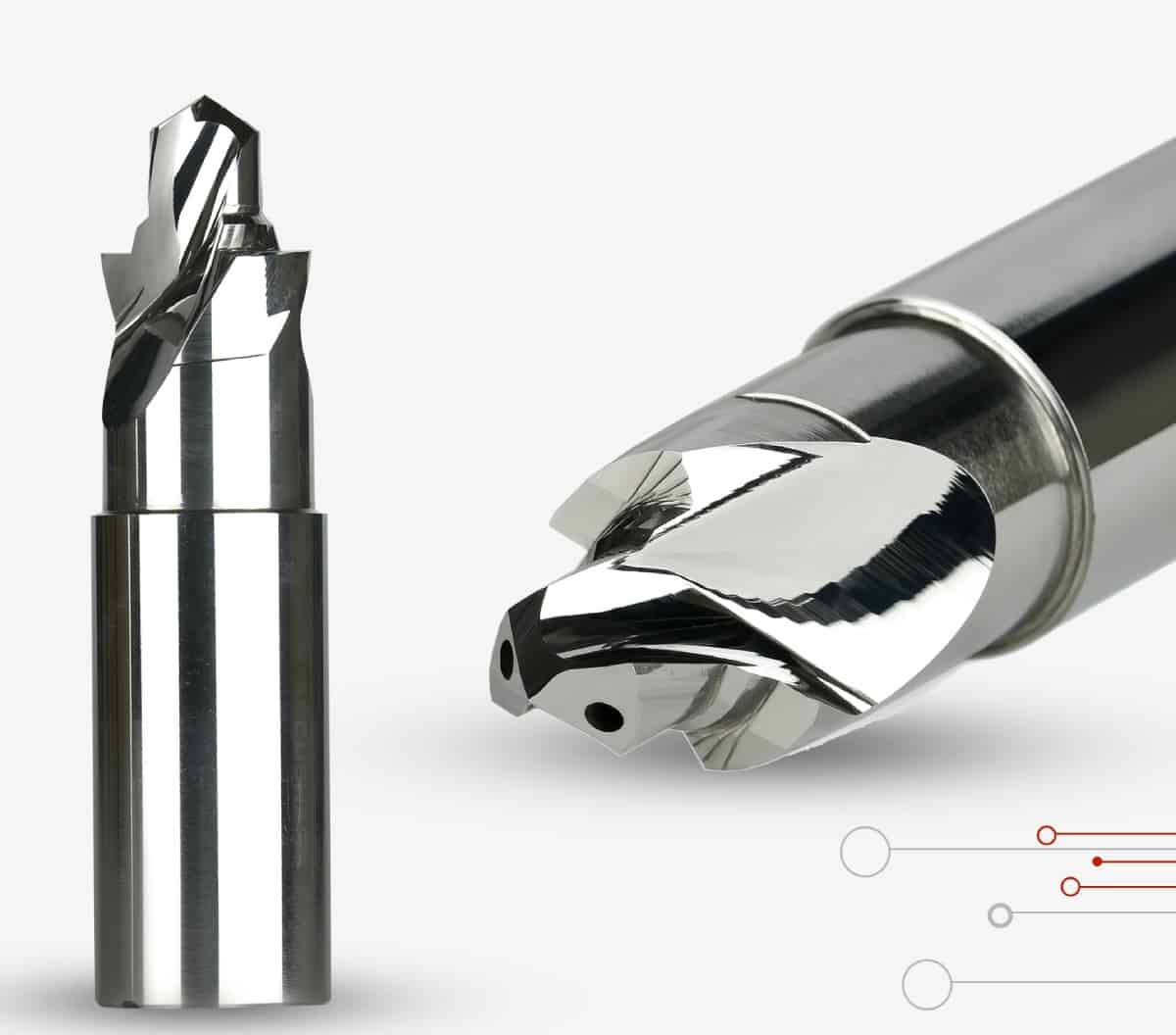End mills are a type of milling cutter that are necessary for a milling machine’s cutting capability, since they are the most extensively used machine tool in the manufacturing business. The milling machine market is likely to develop even more in the next years, according to a recent data research by ‘Strategy.’ End milling is one of the most popular machining and application methods in the industrial world.
A milling cutter known as an end mill is a type of milling cutter. It differs from a drill in terms of application, geometry, and manufacturing.
While a drill bit can only cut in the axial direction, an end mill can generally cut in all directions, though they don’t perform as well as a drill in drilling applications.
End mills are flexible cutting tools that can be used for slotting, profiling, face milling, contouring, and drilling, among other things. High-speed steel (HSS) or tungsten carbide is the most typical materials used.
Selection Guidelines for End Mills
- Length
- Shorter endmill are more stiff, less expensive, and may produce a finer finish (as a corollary, just the length of endmill beyond the cutting edge that is absolutely essential should be exposed).
- While longer endmill are less stiff and allow for deeper cuts, they are more expensive, may not offer as good a finish, and may increase runout.
- Diameter
- Larger diameter tools are stiffer, which allows them to clear more material in a single pass. They will also be able to get a better finish.
- When profiling or cutting off pieces, smaller diameter tools have a smaller radius at the corners, allowing you to remove less material, resulting in less waste and fewer chips. This could endanger people’s lives.
- No. of Flutes
- For slotting or heavy stock removal, one, two, or three flutes are ideal.
- Four or more flutes improve tool stiffness and produce a finer finish.
- Material
- The cost of a tool and how long it lasts are inextricably linked.
- Coatings
- Coatings will enable for faster feeds and longer tool life.
- Certain coatings make it difficult for material to stick to the bit.
Solid Carbide Endmill
Solid Carbide Endmill is often more stiff than HSS end mills and can be used 2-3 times faster. This is mostly due to carbide’s material characteristics, which allow for a far higher heat tolerance.
Profile milling, tracer milling, face milling, and plunging are all milling operations that use endmills.
In recent years, high-efficiency milling has received a lot of attention as a means to significantly boost metal removal rates using solid carbide endmill cutter on nearly any milling machine. Many firms, however, make the error of confusing HSM (high-speed machining) with HFM (high-frequency machining) (high feed machining).
The material of the milling cutter cutting part and the material of the milling cutter’s cutting portion are used to classify Solid carbide endmill cutter.
To maximize this high-speed milling method, solid carbide endmill designs are rapidly emerging. The use of a tiny or light breadth of cut allows the endmill chip gullets to be smaller, allowing more flutes to be added with longer lengths of cut.
Solid carbide endmill have a higher stiffness, better heat resistance, and faster cutting speeds than HSS end mills. This increases your productivity while also allowing you to cut a larger variety of (harder) materials. Carbide end mills are frequently used for finishing.
Accusharp Cutting Tool has a wide selection of high-performance solid carbide square shoulder end mills, ball nose cutters, and finish end mills for increased productivity and tool life. This product line includes universal end mills as well as end mills that are suited for specific work piece materials.
Universal products provide complete machining flexibility at a competitive price.
Optimized end mills are designed for OEMs and first-tier suppliers who need to produce large quantities of a single component and need their processes to be fully optimized to reduce cycle times and lower costs per item.
Milling cutter is a must-have item in any machine shop. End mills and drill bits, like all cutting instruments, lose their cutting edge with time. You should invest in some tools for a solid carbide endmill maker if you are tired of dealing with failing tools and the work of resharpening your cutting tools.
When it comes to tool manufacturing, carbide has numerous distinct advantages. Some shops utilise high-speed steel cutters, but they have their own set of problems. Although most steel alloys are strong, they suffer from the same problem that all metal tools do. If you overheat them, they will lose their cool and begin to soften.
High-temperature steel is a specifically designed steel alloy capable of withstanding intense temperatures. HSS tools are inexpensive and feature a strong cutting edge. This means you can use them in areas where traditional steel tools wouldn’t be able to withstand the heat. Despite this benefit over standard steel, you will still need to use these tools at a slower speed.
Carbide cutting tool are required if you wish to begin machining at higher speeds without jeopardizing the tool’s lifespan. Carbide is a one of a kind high-performance tool material that is specifically developed to keep a cutting edge while also resisting heat.
Carbide tools may appear to be metallic, but they are actually made up of powdered ceramic and a metal binding substance. The ceramic that lends carbide its name, tungsten carbide, is twice as dense and strong as steel.
Because ceramic does not have the same changeable structure as metal, it helps to make them significantly more heat resistant than other tools. A ceramic will not soften no matter how hot it gets, at least not at the temperatures milling cutters will encounter.
Many solid carbide endmill manufacturers coat their tools with protective coatings to add a little extra strength. Coating materials such as titanium aluminium nitride (TiAlN) can protect your end mills from the high temperatures associated with high-speed operation.
TiAlN is often utilised because when heated to high temperatures, it forms a thin layer of aluminium oxide. This aluminium oxide layer protects your end mills from the damaging effects of high heat, allowing them to last longer.
Accusharp Cutting Tools manufactures a full range of carbide and solid carbide endmill cutter made from ultra-micro grain carbide, which increases hardness while maintaining toughness. We are the leading firm for Solid carbide endmill manufacturers India.
Solid Carbide Endmill from Accusharp Cutting Tools in a variety of specifications:
- Multi-Purpose solid carbide end mills are designed to provide the desired surface finish in a wide range of materials.
- To eliminate vibration at higher speeds, variable helix unique flute geometry tools are provided in a range of forms.
- Roughing end mills made of carbide have a unique design that allows for high feed rates and heavy duty grinding.
- Solid Carbide endmill are perfect for high-volume, difficult-to-machine jobs. Cost-effective manufacture is ensured by engineered geometries and sophisticated coatings. Cutting dimensions are constructed into tool styles to fit a variety of tasks, giving you more options.
Solid Carbide endmill are available in a variety of shapes and sizes for roughing and finishing operations. Solid carbide or coolant through can be used to make them. For our customers’ individual demands, the number of flutes and types of end characteristics can be adjusted.
Solid Carbide endmill are used for a variety of tasks, including finishing, roughing, and material-specific applications. To ensure that your investment is protected and that you get the most out of your equipment.
Carbide tooling is highly efficient in use and maintains its cutting edge well even at high machining temperatures. Carbide tools have a wider cutting speed range and are more rigid than HSS tools. Carbide tools are well-known for their superior surface polish.
Carbide is used in a wide range of cutting applications, from boring to face milling and beyond, due to these advantages. When machining cast iron, polymers, and other nonferrous materials, carbide is frequently utilised.
The bulk of machining applications use Solid carbide endmill, while HSS is a smaller but important portion of the market. Carbide knocks HSS out of the water when it comes to cutting speed.
Features:
- Each endmill tooth is involved in intermittent cutting on a regular basis.
- The cutting thickness of each cutter tooth varies during the cutting operation.
- Maximum metal removal rates and better chip evacuation are achieved with optimal flute shape.
- Innovative new geometries created in collaboration with our foreign development partners, who have decades of carbide tooling design and development experience. The result is a wide selection of cutting instruments that are state-of-the-art and function exceptionally well.
- Cutting in the middle with the option of drilling.
- Extra positive dubbing reinforces the corner for longer tool life.
Application Industry:
- Aerospace and aircrafts
- Medical Equipment industry
- Die and Mould
- Automation Industry
- Machine tool industry
- Construction equipment industry.
- Energy
Fabrication Industry.


